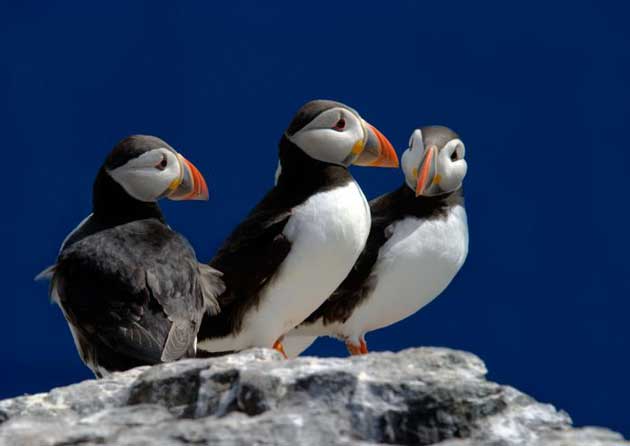Mystery of tumbling puffin population

Numbers of puffins at England's largest colony, on the Farne Islands off the Northumberland coast, have mysteriously tumbled by a third in the past five years.
Breeding pairs of the small seabirds have decreased on the National Trust-owned islands from 55,674 in 2003 to 36,500 this year.
Results of the count, which was carried out by the team of nine National Trust wardens across eight of the islands, came as a shock. All eight islands showed a decrease in population, with four showing a dramatic decrease of up to 50 per cent.
"The results from this survey have completely surprised us, as we were predicting another rise in the numbers of breeding pairs," said the head warden, David Steel. "Stocks of sand eels, the staple food of puffins in the summer, are in good supply around the islands and there is a lack of ground predators, creating a good environment for puffins to breed."
He added: "Extensive monitoring work shows that good numbers of young puffins are successfully fledging each year but it would appear they're just not coming back to the islands the following years. Presumably fewer birds are surviving over winter than are needed to maintain current numbers."
Staple Island and Brownsman Island, where the majority of puffins can be found, have seen the numbers of breeding pairs fall by more than 30 per cent since the last survey was carried out in 2003.
Possible factors behind the decline are not yet properly understood but according to the trust, "this dramatic drop in numbers would suggest there is something happening at sea during the winter, for example, an intensification of storms as a result of our changing climate which could affect the ability of puffins to find food."
John Walton, the trust's property manager for the Farne Islands and the Northumberland coast, said that in almost 30 years of working with the Farne puffins this was the first downturn in the population he had witnessed. "With such a dramatic fall in numbers of breeding puffins on the islands, we need to do some further work to find out why things are changing, and whether this is a long term trend," he said. "We'll being carrying out sample surveys next year on some of the islands to build up a more detailed picture of what is happening."
Records for the number of breeding pairs of puffins found on the Farne Islands date back to the 1930s, but the first detailed count took place in 1969 when there were 6,800 pairs. The islands hold the largest colony of puffins in England, and constitute the fourth largest colony in the UK.
Puffins nest underground in burrows, and during the survey, which began in May, the wardens put their arms down holes to make sure the nests were occupied.
The islands are home to many seabirds as well as a population of grey seals.
Join our commenting forum
Join thought-provoking conversations, follow other Independent readers and see their replies
Comments
Bookmark popover
Removed from bookmarks